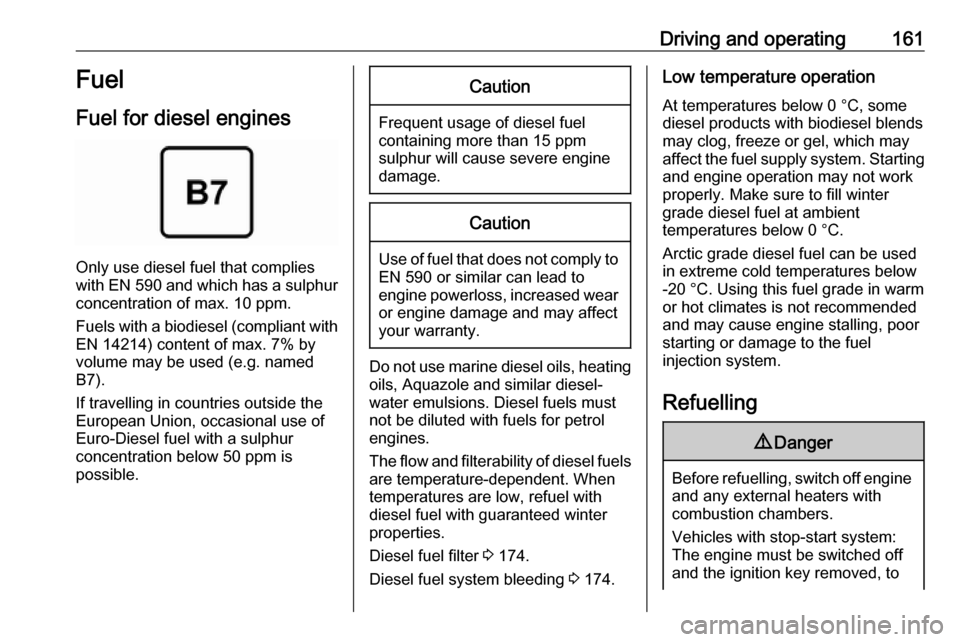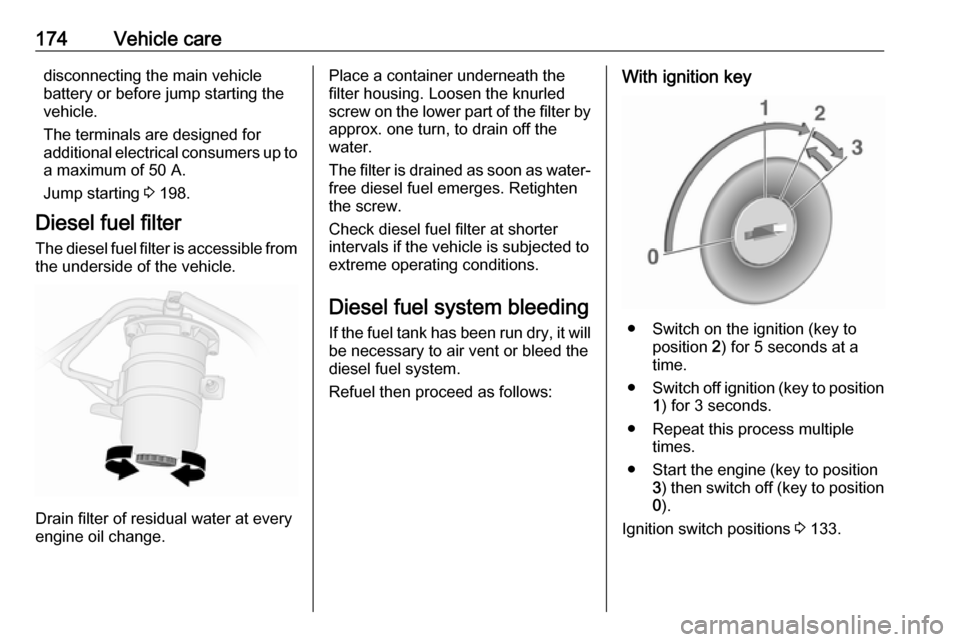key OPEL VIVARO B 2018.5 Service Manual
[x] Cancel search | Manufacturer: OPEL, Model Year: 2018.5, Model line: VIVARO B, Model: OPEL VIVARO B 2018.5Pages: 241, PDF Size: 5.58 MB
Page 148 of 241

146Driving and operating2. Open left-hand door and pull fuelfiller flap to open.
3. Unscrew protective cap anticlockwise from the filler neck.
Caution
The AdBlue protective cap is the
blue lower cap (arrowed in
illustration), and the fuel filler cap
is the black upper cap 3 161.
In case of incorrect refilling, do not switch on ignition. Seek the
assistance of a workshop
immediately.
4. Fully insert the pump nozzle into the filler neck and switch it on.
5. When refilling is complete, mount the protective cap and turn
clockwise until it engages.
6. Close fuel filler flap and left-hand door.
AdBlue canister Note
Only use the designated AdBlue
canisters for refilling, to prevent a
topping-up of too much AdBlue.
Additionally, the fumes in the tank
are captured in the canister and do
not emerge.
Note
Since AdBlue has a limited
durability, check the date of expiry
before refilling.
1. Switch off engine and remove key
from ignition switch.
2. Open left-hand door and pull fuel filler flap to open.
3. Unscrew protective capanticlockwise from the filler neck.
Caution
The AdBlue protective cap is the
blue lower cap (arrowed in
illustration), and the fuel filler cap
is the black upper cap 3 161.
In case of incorrect refilling, do not switch on ignition. Seek the
assistance of a workshop
immediately.
4. Open AdBlue canister.
Page 163 of 241

Driving and operating161Fuel
Fuel for diesel engines
Only use diesel fuel that complies
with EN 590 and which has a sulphur
concentration of max. 10 ppm.
Fuels with a biodiesel (compliant with
EN 14214) content of max. 7% by
volume may be used (e.g. named
B7).
If travelling in countries outside the
European Union, occasional use of Euro-Diesel fuel with a sulphur
concentration below 50 ppm is
possible.
Caution
Frequent usage of diesel fuel containing more than 15 ppm
sulphur will cause severe engine
damage.
Caution
Use of fuel that does not comply to EN 590 or similar can lead to
engine powerloss, increased wear
or engine damage and may affect
your warranty.
Do not use marine diesel oils, heating
oils, Aquazole and similar diesel-
water emulsions. Diesel fuels must
not be diluted with fuels for petrol
engines.
The flow and filterability of diesel fuels are temperature-dependent. When
temperatures are low, refuel with
diesel fuel with guaranteed winter
properties.
Diesel fuel filter 3 174.
Diesel fuel system bleeding 3 174.
Low temperature operation
At temperatures below 0 °C, some
diesel products with biodiesel blends
may clog, freeze or gel, which may
affect the fuel supply system. Starting
and engine operation may not work
properly. Make sure to fill winter
grade diesel fuel at ambient
temperatures below 0 °C.
Arctic grade diesel fuel can be used
in extreme cold temperatures below
-20 °C. Using this fuel grade in warm
or hot climates is not recommended
and may cause engine stalling, poor starting or damage to the fuel
injection system.
Refuelling9 Danger
Before refuelling, switch off engine
and any external heaters with
combustion chambers.
Vehicles with stop-start system:
The engine must be switched off
and the ignition key removed, to
Page 176 of 241

174Vehicle caredisconnecting the main vehicle
battery or before jump starting the vehicle.
The terminals are designed for
additional electrical consumers up to a maximum of 50 A.
Jump starting 3 198.
Diesel fuel filter The diesel fuel filter is accessible from
the underside of the vehicle.
Drain filter of residual water at every
engine oil change.
Place a container underneath the
filter housing. Loosen the knurled
screw on the lower part of the filter by approx. one turn, to drain off the
water.
The filter is drained as soon as water-
free diesel fuel emerges. Retighten
the screw.
Check diesel fuel filter at shorter
intervals if the vehicle is subjected to
extreme operating conditions.
Diesel fuel system bleeding
If the fuel tank has been run dry, it will be necessary to air vent or bleed the
diesel fuel system.
Refuel then proceed as follows:With ignition key
● Switch on the ignition (key to position 2) for 5 seconds at a
time.
● Switch off ignition (key to position
1 ) for 3 seconds.
● Repeat this process multiple times.
● Start the engine (key to position 3) then switch off (key to position
0 ).
Ignition switch positions 3 133.
Page 177 of 241

Vehicle care175With power button
● Insert the electronic key in thecard reader.
● Press START/STOP without
pressing any of the pedals.
● Wait a few minutes before starting engine.
Power button 3 133.
If the engine fails to start, seek the
assistance of a workshop.
Starting the engine 3 135.
Wiper blade replacement
Wiper blades on the windscreen
Before replacing the wiper blades,
move the wiper lever to the
maintenance position (if equipped).
Windscreen wiper and washer 3 86.
Lift the wiper arm, press button to
disengage the wiper blade and
remove.
Attach new wiper blade slightly
angled to the wiper arm and push until
it engages.
Lower wiper arm carefully.
Wiper blade on the rear window
Lift wiper arm, press retaining lugs
together to disengage the wiper blade
and raise to remove.
Lower wiper arm carefully.
When attaching new wiper blade,
ensure it is engaged securely.
Page 187 of 241

Vehicle care185No.Circuit1Battery backup (with electronic
key system)2Adaptations3Adaptations4Vehicle battery (with electronic key system)5Additional heating and ventila‐
tion / Air conditioning system6Supplementary heating and
ventilation system7Electric exterior mirrors / Addi‐
tional adaptations8Heated exterior mirrors9Radio / Multimedia / Electric
exterior mirrors / Diagnostic
socket10Multimedia / Trailer hitch11Courtesy lights / Battery
discharge protectionNo.Circuit12Right-hand high beam / Left-
hand low beam / Sidelights /
Right-hand daytime running
light13Hazard warning flashers / Turn
lights14Central locking15Left-hand high beam / Right-
hand low beam / Tail lights /
Left-hand daytime running light16Front fog lights / Rear fog lights /
Number plate lighting17Alarm / Horn / Lighting / Wiper18Instrument cluster19Heating and ventilation system20Rear window wiper / Wind‐
screen washer pump / Horn21General battery22Reversing lights23Brake switchNo.Circuit24Fuel injection / Starter25Airbag / Steering column lock26Passenger power window27Power steering28Brake lights29Battery backup (with electronic
key system)30Service display31Cigarette lighter / Power outlet32Heating and ventilation system33Brake lights / ABS / Immobiliser34Interior lighting / Air conditioning35Starting with electronic key
system36Rear window wiper37Warning chimes38Load compartment power outlet39Driver power window
Page 188 of 241

186Vehicle careNo.Circuit40Rear power outlet41Starting / Body control module42Heated seats43Tachograph44Windscreen wiper45Heating / Air conditioning
After having changed defective fuses,
replace the trim panel.
Vehicle tools
Tools
The jack, wheel wrench, wheel bolt
sleeve, torx key, adapters, wheel
cover hook, towing eye are contained
in a unit, stowed under the driver's
seat.
Slide seat forwards and fold the
backrest forwards 3 48 to access the
tool box. The tool box may be secured
in position with a wing nut. Rotate
wing nut anticlockwise to release.
Wheel changing 3 195.
Spare wheel 3 197.
Vehicles with tyre repair kit: The wheel cover hook and torx key are
stored within the tyre repair kit case,
stowed under the driver's seat.
Tyre repair kit 3 192.
Page 208 of 241

206Service and maintenanceRomania, Bulgaria, Moldova, Cyprus:
Maintenance of your vehicle is
required every 30,000 km or after
one year, whichever occurs first,
unless otherwise indicated by the service display.
Turkey:
Maintenance of your vehicle is
required every 20,000 km or after
one year, whichever occurs first,
unless otherwise indicated by the
service display.
Morocco, South Africa, Russia,
Ukraine, Belarus, Kazakhstan:
Maintenance of your vehicle is
required every 15,000 km or after
one year, whichever occurs first, unless otherwise indicated by the
service display.
Algeria, Tunisia, Malta, Singapore:
Maintenance of your vehicle is
required every 10,000 km or after
one year, whichever occurs first,
unless otherwise indicated by the service display.Egypt:
Maintenance of your vehicle is
required every 8,000 km or after
one year, whichever occurs first, unless otherwise indicated by the
service display.
Severe operating conditions exist if
one or more of the following
circumstances occur frequently: Cold
starting, stop and go operation, trailer operation, mountain driving, driving
on poor and sandy road surfaces,
increased air pollution, presence of
airborne sand and high dust content,
driving at high altitude and large
variations of temperature. Under
these severe operating conditions, certain service work may be required
more frequently than the regular service interval.
Service display 3 94.
Confirmations
Confirmation of service is recorded in the Service and warranty booklet.
The date and mileage is completed
with the stamp and signature of the
servicing workshop.Make sure that the Service and
warranty booklet is completed
correctly as continuous proof of
service is essential if any warranty or
goodwill claims are to be met, and is
also a benefit when selling the
vehicle.
Service display The service interval is based on
several parameters depending on
usage.
The service display, located in the
Driver Information Centre, indicates
when the next service is due. Seek
the assistance of a workshop.
Service display 3 94.
Page 226 of 241

224Customer informationCustomer
informationCustomer information ................224
Declaration of conformity .........224
REACH .................................... 228
Registered trademarks ............228
Vehicle data recording and pri‐
vacy ........................................... 228
Event data recorders ...............228
Radio Frequency Identification (RFID) ..................................... 231Customer information
Declaration of conformity
Radio transmission systems
This vehicle has systems that
transmit and / or receive radio waves
subject to Directive 2014/53/EU. The
manufacturers of the systems listed
below declare conformity with
Directive 2014/53/EU. The full text of
the EU declaration of conformity for each system is available at the
following internet address:
www.opel.com/conformity.
Importer is
Opel / Vauxhall, Bahnhofsplatz,
65423 Ruesselsheim am Main,
Germany.
Electronic key transmitter
Continental Automotive
1 Rue de Clairefontaine, 78120
Rambouillet, France
Operation frequency: 433 MHz
Maximum output: 10 mW ERPImmobiliser
Visteon Electronics
04 Rue Nelson Mandela, Zone
Industrielle Borj Cedria, 2055 Bir El
Bey, Tunisia
Operation frequency: 125 kHz
Maximum output:
42 dBµA/m @ 10 m
Immobiliser
Continental Automotive
1 Rue de Clairefontaine, 78120
Rambouillet, France
Operation frequency: 125 kHz
Maximum output:
42 dBµA/m @ 10 m
IntelliLink Touch
Continental Automotive
1 Rue de Clairefontaine, 78120
Rambouillet, France
Operation frequency: N/A
Maximum output: N/A
NAVI 50 IntelliLink / NAVI 80
IntelliLink
LG Electronics
Page 231 of 241

Customer information229This data includes, for example:● Vehicle status information (e.g. wheel rotation rate, speed,
movement delay, lateral
acceleration, "seatbelts
fastened" display),
● Ambient conditions (e.g. temperature, rain sensor,
distance sensor).
Most of this data is volatile and is processed only in the vehicle itself,and not beyond the operating time.
Moreover, many control units include
data storage device (amongst others the vehicle key). This is used to allow
information to be documented
temporarily or permanently on vehicle
condition, component stress,
maintenance requirements and
technical events and errors.
The following information, for
example, is stored:
● System component operating states (e.g. fill level, tyre
pressure, battery status),
● State of charge of the high voltage battery, estimated range
(in the case of electric vehicles),● Faults and defects in important system components (e.g. lights,
brakes),
● System reactions in special driving situations (e.g. triggeringof an airbag, actuation of the
stability control systems),
● Information on events damaging the vehicle.
In special cases (e.g. if the vehicle
has detected a malfunction), it may be
necessary to save data that would
otherwise just be volatile.
When you use services, the operating data saved can be read together withthe vehicle identification number andused if necessary. Staff working for
the service net-work (e.g. garages,
manufacturers) or third parties (e.g.
breakdown services) can read the
data from the vehicle. Services
include repair services, maintenance
processes, warranty cases and
quality assurance measures.
Data is generally read via the OBD
(On-Board Diagnostics) port
prescribed by law in the vehicle. The operating data which has been read
out documents the technical conditionof the vehicle or individual
components and assists with fault
diagnosis, compliance with warranty
obligations and quality improvement.
This data, in particular information on
component stress, technical events,
operator errors and other faults, is
transmitted to the manufacturer
where appropriate, together with the vehicle identification number. The
manufacturer is also subject to
product liability. The manufacturer
potentially also needs operating data
from vehicles for product recalls.
Fault memories in the vehicle can be
reset by a service company when
carrying out servicing or repairs.
Comfort and infotainment
functions
Comfort settings and custom settings can be stored in the vehicle and
changed at any time.
Page 235 of 241

233Child locks ................................... 32
Child restraint installation locations ................................... 68
Child restraints.............................. 66
Child restraint systems ................66
Cigarette lighter ........................... 90
Cleaning the vehicle ...................201
Climate control ............................. 17
Climate control systems .............118
Clock ............................................ 88
Coat hooks ................................... 75
Coin holder ................................... 73
Control indicators.......................... 94
Control of the vehicle .................132
Controls ........................................ 85
Controls in steering wheel ............85
Convex shape .............................. 40
Coolant ....................................... 170
Coolant and antifreeze ...............207
Coolant heater ............................ 124
Cooling (A/C) .............................. 119
Cornering lights .......................... 112
Cruise control ....................103, 153
Cupholders .................................. 75
Curtain airbag system .................. 64
D Danger, Warnings and Cautions ...4
Dashboard .................................... 10
Daytime running lights ........111, 112Declaration of conformity ............224
DEF ............................................ 142
Demisting and defrosting ..............17
Diesel exhaust fluid ....................142
Diesel fuel ................................... 161
Diesel fuel filter .......................... 174
Diesel fuel system bleeding .......174
Diesel particle filter ....................141
Directional tyres ..................187, 197
Distance to service .......................94
Document tray .............................. 75
Door locks..................................... 25
Door open .................................. 103
Door panel storage .......................76
Doors ............................................ 32
Double cab ................................... 76
DPF (diesel particle filter) ...........141
Driver assistance systems ..........153
Driver Information Centre ...........103
Driving characteristics and towing tips .............................. 163
Driving economically................... 131
Driving hints ........................ 131, 132
Driving style indicator ...................93
E
ECO mode .................................. 131
ecoScoring.................................. 106
Electric adjustment ......................41
Electrical accessories ...................89Electrical system......................... 182
Electronic climate control system 120
Electronic data recording ..............43
Electronic key system ...................23
Electronic Stability Program .....
................................ 100, 151, 164
Electronic Stability Program off . 100
End-of-life vehicle recovery .......167
Engine air filter............................ 169
Engine air flow indicator .............169
Engine coolant ........................... 170
Engine coolant temperature ......100
Engine data ............................... 212
Engine Drag Torque Control ......151
Engine exhaust .......................... 141
Engine identification ...................210
Engine oil ................... 168, 207, 211
Engine oil additives ....................207
Engine oil level .......................... 106
Engine oil pressure ....................101
Engine oil viscosity grades .........207
Enhanced Traction function 150, 151
Entry lighting .............................. 116
Event data recorders ..................228
Exhaust gases ....................141, 200
Exit lighting ................................ 116
Exterior care .............................. 201
Exterior light ............................... 102
Exterior lighting ....................14, 110
Exterior mirrors ............................. 40